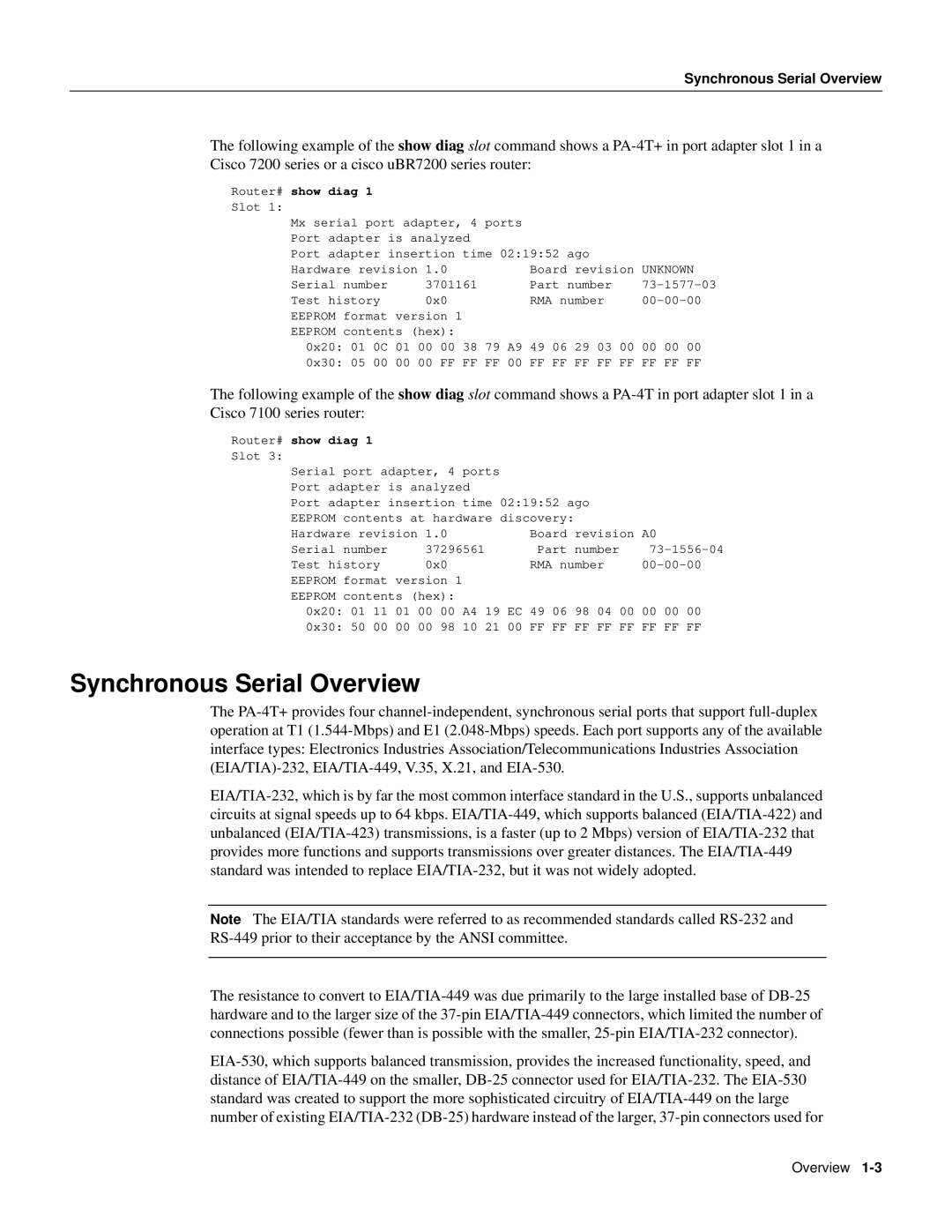Synchronous Serial Overview
The following example of the show diag slot command shows a PA-4T+ in port adapter slot 1 in a Cisco 7200 series or a cisco uBR7200 series router:
Router# show diag 1
Slot 1:
Mx serial port adapter, 4 | ports | | | | | |
Port adapter is analyzed | | | | | | |
Port adapter insertion | time 02:19:52 ago | | | |
Hardware revision 1.0 | | | Board revision UNKNOWN |
Serial number | 3701161 | | Part number | 73-1577-03 |
Test history | 0x0 | | | RMA number | 00-00-00 |
EEPROM format | version 1 | | | | | | | |
EEPROM contents (hex): | | | | | | | |
0x20: 01 | 0C | 01 00 00 | 38 | 79 A9 | 49 06 | 29 | 03 00 00 00 | 00 |
0x30: 05 00 | 00 00 FF | FF | FF 00 | FF FF FF FF FF FF FF FF |
The following example of the show diag slot command shows a PA-4T in port adapter slot 1 in a
Cisco 7100 series router:
Router# show diag 1 | | | | |
Slot 3: | | | | |
Serial port adapter, 4 | ports | | |
Port adapter is analyzed | | |
Port adapter insertion | time 02:19:52 ago | |
EEPROM contents at hardware discovery: | |
Hardware revision | 1.0 | | Board revision | A0 |
Serial number | 37296561 | Part number | 73-1556-04 |
Test history | 0x0 | | RMA number | 00-00-00 |
EEPROM format version 1 | | | |
EEPROM contents (hex): | | | |
0x20: 01 11 01 00 00 | A4 19 | EC 49 06 98 04 00 | 00 00 00 |
0x30: 50 00 00 00 98 | 10 21 | 00 FF FF FF FF FF FF FF FF |
Synchronous Serial Overview
The PA-4T+ provides four channel-independent, synchronous serial ports that support full-duplex operation at T1 (1.544-Mbps) and E1 (2.048-Mbps) speeds. Each port supports any of the available interface types: Electronics Industries Association/Telecommunications Industries Association (EIA/TIA)-232, EIA/TIA-449, V.35, X.21, and EIA-530.
EIA/TIA-232, which is by far the most common interface standard in the U.S., supports unbalanced circuits at signal speeds up to 64 kbps. EIA/TIA-449, which supports balanced (EIA/TIA-422) and unbalanced (EIA/TIA-423) transmissions, is a faster (up to 2 Mbps) version of EIA/TIA-232 that provides more functions and supports transmissions over greater distances. The EIA/TIA-449 standard was intended to replace EIA/TIA-232, but it was not widely adopted.
Note The EIA/TIA standards were referred to as recommended standards called RS-232 and
RS-449 prior to their acceptance by the ANSI committee.
The resistance to convert to EIA/TIA-449 was due primarily to the large installed base of DB-25 hardware and to the larger size of the 37-pin EIA/TIA-449 connectors, which limited the number of connections possible (fewer than is possible with the smaller, 25-pin EIA/TIA-232 connector).
EIA-530, which supports balanced transmission, provides the increased functionality, speed, and distance of EIA/TIA-449 on the smaller, DB-25 connector used for EIA/TIA-232. The EIA-530 standard was created to support the more sophisticated circuitry of EIA/TIA-449 on the large number of existing EIA/TIA-232 (DB-25) hardware instead of the larger, 37-pin connectors used for

